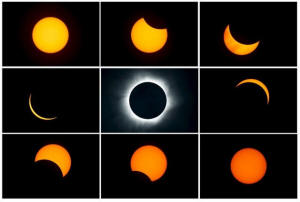|
U.S. total solar eclipse sparks spectator
excitement
 Send a link to a friend
Send a link to a friend
 [June 24, 2017]
By Irene Klotz [June 24, 2017]
By Irene Klotz
CAPE CANAVERAL, Fla. (Reuters) - The first
total solar eclipse across the continental United States in a century is
expected to spark watching parties and traffic jams as it darkens skies
from Oregon to South Carolina, authorities said on Wednesday.
During the Aug. 21 eclipse, the moon will pass between the sun and
Earth, blocking the face of the sun and leaving only its outer
atmosphere, or corona, visible in the sky.
It is the first coast-to-coast total eclipse since 1918.
Weather permitting, people can watch as the moon's 70-mile (113-km) wide
shadow crosses through 14 states from 10:15 a.m. PDT (1715 GMT) around
Lincoln Beach, Oregon, to 2:49 p.m. EDT (1849 GMT) in McClellanville,
South Carolina.

With 200 million Americans within a day's drive of the path, national
parks and highways officials are bracing for a travel surge.
“Be prepared," Martin Knopp of the Federal Highway Administration said
at a news conference, cautioning drivers against simply showing up.
"It’s not the time to pull over and be on the side of the road.”
Travel groups and many scientists will be heading to Oregon's northwest
desert seeking favorable weather for viewing, according to the website
eclipsophile.com.
Total solar eclipses occur somewhere on Earth every year or so, but most
cast their shadow over oceans or remote land. The last total eclipse
over part of the contiguous U.S. was in 1979.
All of North America will experience a partial eclipse, though the
difference between a full and partial eclipse is "literally the
difference between night and day," said astronomer Rick Fienberg of the
American Astronomical Society.

[to top of second column] |

A combination photograph shows the beginning (top L) to the end (top
L to bottom R) of a total solar eclipse as seen from the beach of
Ternate island, Indonesia, March 9, 2016. REUTERS/Beawiharta

He noted that even a 99 percent eclipse will not reveal the sun's
corona. And during a total eclipse, the temperature drops and the
horizon is ringed by the colors of sunset.
"The sky gets deep twilight blue and bright stars and planets come
out," Fienberg said. "Animals and birds behave strangely, like it's
the end of the day."
NASA said it plans to fly high-altitude research balloons and
airplanes for solar physics and other experiments. Nearly a dozen
U.S. science satellites will observe the sun and Earth.
The U.S. space agency will also broadcast the eclipse live from
locations along the path.
Experts caution that the only safe time to look at the sun without
special eclipse glasses is during totality when the surface of the
sun is completely blocked by the moon.
(Editing by Letitia Stein and Cynthia Osterman)
[© 2017 Thomson Reuters. All rights
reserved.]
Copyright 2017 Reuters. All rights reserved. This material may not be published,
broadcast, rewritten or redistributed.
 |